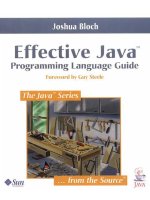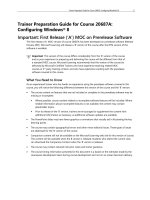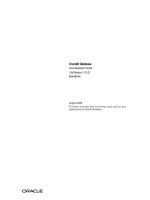java 8 pocket guide
Bạn đang xem bản rút gọn của tài liệu. Xem và tải ngay bản đầy đủ của tài liệu tại đây (8.25 MB, 241 trang )
www.it-ebooks.info
www.it-ebooks.info
Robert Liguori and Patricia Liguori
Java 8 Pocket Guide
www.it-ebooks.info
Java 8 Pocket Guide
by Robert Liguori and Patricia Liguori
Copyright © 2014 Gliesian, LLC. All rights reserved.
Printed in the United States of America.
Published by O’Reilly Media, Inc., 1005 Gravenstein Highway North, Sebasto‐
pol, CA 95472.
O’Reilly books may be purchased for educational, business, or sales promotional
use. Online editions are also available for most titles (aribookson
line.com). For more information, contact our corporate/institutional sales de‐
partment: 800-998-9938 or
Editors: Mike Loukides and Meghan Blanchette
Production Editor: Melanie Yarbrough
Proofreader: Gillian McGarvey
Indexer: WordCo Indexing Services
Cover Designer: Karen Montgomery
Interior Designer: David Futato
Illustrator: Rebecca Demarest
April 2014: First Edition
Revision History for the First Edition:
2014-04-07: First release
See for release de‐
tails.
Nutshell Handbook, the Nutshell Handbook logo, and the O’Reilly logo are
registered trademarks of O’Reilly Media, Inc. Java 8 Pocket Guide, the cover
image of a Javan tiger, and related trade dress are trademarks of O’Reilly Media,
Inc.
Many of the designations used by manufacturers and sellers to distinguish their
products are claimed as trademarks. Where those designations appear in this
book, and O’Reilly Media, Inc. was aware of a trademark claim, the designations
have been printed in caps or initial caps.
While every precaution has been taken in the preparation of this book, the
publisher and authors assume no responsibility for errors or omissions, or for
damages resulting from the use of the information contained herein.
ISBN: 978-1-491-90086-4
[M]
www.it-ebooks.info
This book is dedicated to our beautiful, awesome-tastic daughter,
Ashleigh.
www.it-ebooks.info
www.it-ebooks.info
Table of Contents
Preface xi
Part I. Language
Chapter 1:
Naming Conventions 3
Class Names 3
Interface Names 3
Method Names 4
Instance and Static Variable Names 4
Parameter and Local Variable Names 4
Generic Type Parameter Names 4
Constant Names 5
Enumeration Names 5
Package Names 5
Annotation Names 6
Acronyms 6
Chapter 2:
Lexical Elements 7
Unicode and ASCII 7
Comments 9
v
www.it-ebooks.info
Keywords 10
Identifiers 11
Separators 12
Operators 12
Literals 14
Escape Sequences 17
Unicode Currency Symbols 18
Chapter 3:
Fundamental Types 21
Primitive Types 21
Literals for Primitive Types 22
Floating-Point Entities 23
Numeric Promotion of Primitive Types 26
Wrapper Classes 27
Autoboxing and Unboxing 28
Chapter 4:
Reference Types 31
Comparing Reference Types to Primitive Types 32
Default Values 32
Conversion of Reference Types 34
Converting Between Primitives and Reference Types 35
Passing Reference Types into Methods 35
Comparing Reference Types 37
Copying Reference Types 40
Memory Allocation and Garbage Collection of Reference
Types 41
Chapter 5: Object-Oriented Programming 43
Classes and Objects 43
Variable-Length Argument Lists 49
Abstract Classes and Abstract Methods 51
vi | Table of Contents
www.it-ebooks.info
Static Data Members, Static Methods, Static Constants, and
Static Initializers 52
Interfaces 53
Enumerations 54
Annotation Types 55
Functional Interfaces 57
Chapter 6: Statements and Blocks 59
Expression Statements 59
Empty Statement 60
Blocks 60
Conditional Statements 60
Iteration Statements 62
Transfer of Control 64
Synchronized Statement 66
Assert Statement 66
Exception Handling Statements 67
Chapter 7:
Exception Handling 69
The Exception Hierarchy 69
Checked/Unchecked Exceptions and Errors 70
Common Checked/Unchecked Exceptions and Errors 71
Exception Handling Keywords 74
The Exception Handling Process 78
Defining Your Own Exception Class 79
Printing Information About Exceptions 80
Chapter 8: Java Modifiers 83
Access Modifiers 84
Table of Contents | vii
www.it-ebooks.info
Other (Nonaccess) Modifiers 85
Part II. Platform
Chapter 9: Java Platform, Standard Edition 89
Common Java SE API Libraries 89
Chapter 10: Development Basics 103
Java Runtime Environment 103
Java Development Kit 103
Java Program Structure 104
Command-Line Tools 106
Classpath 113
Chapter 11:
Memory Management 115
Garbage Collectors 115
Memory Management Tools 117
Command-Line Options 118
Resizing the JVM Heap 121
Metaspace 121
Interfacing with the GC 122
Chapter 12: Basic Input and Output 125
Standard Streams in, out, and err 125
Class Hierarchy for Basic Input and Output 126
File Reading and Writing 127
Socket Reading and Writing 129
Serialization 131
Zipping and Unzipping Files 132
Chapter 13:
New I/O API (NIO.2) 135
The Path Interface 135
viii | Table of Contents
www.it-ebooks.info
The Files Class 136
Additional Features 137
Chapter 14: Concurrency 139
Creating Threads 139
Thread States 140
Thread Priorities 141
Common Methods 141
Synchronization 143
Concurrent Utilities 144
Chapter 15:
Java Collections Framework 149
The Collection Interface 149
Implementations 150
Collection Framework Methods 150
Collections Class Algorithms 151
Algorithm Efficiencies 152
Comparator Functional Interface 153
Chapter 16:
Generics Framework 157
Generic Classes and Interfaces 157
Constructors with Generics 158
Substitution Principle 159
Type Parameters, Wildcards, and Bounds 160
The Get and Put Principle 160
Generic Specialization 161
Generic Methods in Raw Types 162
Chapter 17: The Java Scripting API 165
Scripting Languages 165
Script Engine Implementations 165
Setting Up Scripting Languages and Engines 168
Table of Contents | ix
www.it-ebooks.info
Chapter 18: Date and Time API 171
Legacy Interoperability 172
Regional Calendars 172
ISO Calendar 173
Chapter 19: Lambda Expressions 179
λEs Basics 179
Specific Purpose Functional Interfaces 182
General Purpose Functional Interfaces 182
Resources for λEs 184
Part III. Appendixes
A. Fluent APIs 189
B. Third-Party Tools 191
C. UML Basics 201
Index 211
x | Table of Contents
www.it-ebooks.info
Preface
Designed to be your companion, this Pocket Guide provides a
quick reference to the standard features of the Java programming
language and its platform.
This Pocket Guide provides you with the information you will
need while developing or debugging your Java programs, includ‐
ing helpful programming examples, tables, figures, and lists.
It also contains supplemental information about things such as
the Java Scripting API, third-party tools, and the basics of the
Unified Modeling Language (UML).
The material in this book also provides support in preparing for
the Oracle Certified Associate Java SE 7 Programmer I Exam. If
you are considering pursuing this Java certification, you may also
wish to consider acquiring OCA Java SE 7 Programmer I Study
Guide (Exam 1Z0-803) by Edward Finegan and Robert Liguori
(McGraw-Hill Osborne Media, 2012).
Java coverage in this book is representative through Java SE 8.
However, the primary differences between this Java 8 Pocket
Guide and the prior Java 7 Pocket Guide is the addition of the
Date and Time API and the Lambda Expressions chapters.
xi
www.it-ebooks.info
Book Structure
This book is broken into three parts: Part I, Part II, and Part III.
Chapters 1 through 8 detail the Java programming language as
derived from the Java Language Specification (JLS). Chapters 9
through 19 detail Java platform components and related topics.
The appendixes cover third-party tools and the Unified Modeling
Language.
Conventions Used in This Book
The following typographical conventions are used in this book:
Italic
Indicates new terms, URLs, email addresses, filenames, and
file extensions.
Constant width
Used for program listings, as well as within paragraphs to
refer to program elements such as variable or function
names, databases, data types, environment variables, state‐
ments, and keywords.
Constant width bold
Shows commands or other text that should be typed literally
by the user.
Constant width italic
Shows text that should be replaced with user-supplied values
or by values determined by context.
TIP
This element signifies a tip, suggestion, or general note.
xii | Preface
www.it-ebooks.info
WARNING
This element indicates a warning or caution.
Safari® Books Online
NOTE
Safari Books Online is an on-demand digital library that
delivers expert content in both book and video form from
the world’s leading authors in technology and business.
Technology professionals, software developers, web designers,
and business and creative professionals use Safari Books Online
as their primary resource for research, problem solving, learning,
and certification training.
Safari Books Online offers a range of product mixes and pricing
programs for organizations, government agencies, and individ‐
uals. Subscribers have access to thousands of books, training vid‐
eos, and prepublication manuscripts in one fully searchable da‐
tabase from publishers like O’Reilly Media, Prentice Hall Profes‐
sional, Addison-Wesley Professional, Microsoft Press, Sams,
Que, Peachpit Press, Focal Press, Cisco Press, John Wiley & Sons,
Syngress, Morgan Kaufmann, IBM Redbooks, Packt, Adobe
Press, FT Press, Apress, Manning, New Riders, McGraw-Hill,
Jones & Bartlett, Course Technology, and dozens more. For more
information about Safari Books Online, please visit us online.
Preface | xiii
www.it-ebooks.info
How to Contact Us
Please address comments and questions concerning this book to
the publisher:
O’Reilly Media, Inc.
1005 Gravenstein Highway North
Sebastopol, CA 95472
800-998-9938 (in the United States or Canada)
707-829-0515 (international or local)
707-829-0104 (fax)
We have a web page for this book, where we list errata, examples,
and any additional information. You can access this page at http://
oreil.ly/java-8-pocket-guide.
To comment or ask technical questions about this book, send
email to
For more information about our books, courses, conferences,
and news, see our website at .
Find us on Facebook: />Follow us on Twitter: />Watch us on YouTube: />Authors
Robert James Liguori is the principal for Gliesian LLC. He is an
Oracle Certified Expert, supporting several Java-based air traffic
management and safety applications. Patricia Liguori is a multi-
disciplinary information systems engineer for The MITRE Cor‐
poration. She has been developing real-time air traffic manage‐
ment systems and aviation-related information systems since
1994.
xiv | Preface
www.it-ebooks.info
Acknowledgments
We extend a special thank you to our editor, Meghan Blanchette.
Her oversight and collaboration has been invaluable to this en‐
deavor.
Further appreciation goes out to Michael Loukides (technical
editor of the initial Java Pocket Guide), our technical reviewer
Ryan Cuprak, as well as the various members of the O’Reilly team,
our family, and our friends.
We would also like to thank again all of those who participated
with the original Java Pocket Guide and the Java 7 Pocket Guide.
Most importantly, we thank you for using the book as a reference
guide and for loving Java. Feel free to post a picture of yourself
with the book on Tumblr. It would be nice to see who is using the
book and where it has been (even on vacations). :)
Preface | xv
www.it-ebooks.info
www.it-ebooks.info
PART I
Language
www.it-ebooks.info
www.it-ebooks.info
CHAPTER 1
Naming Conventions
Naming conventions are used to make Java programs more read‐
able. It is important to use meaningful and unambiguous names
comprised of Java letters.
Class Names
Class names should be nouns, as they represent “things” or “ob‐
jects.” They should be mixed case (camel case) with only the first
letter of each word capitalized, as in the following:
public class Fish { }
Interface Names
Interface names should be adjectives. They should end with “able”
or “ible” whenever the interface provides a capability; otherwise,
they should be nouns. Interface names follow the same capitali‐
zation convention as class names:
public interface Serializable { }
public interface SystemPanel { }
3
www.it-ebooks.info
Method Names
Method names should contain a verb, as they are used to make
an object take action. They should be mixed case, beginning with
a lowercase letter, and the first letter of each subsequent word
should be capitalized. Adjectives and nouns may be included in
method names:
public void locate() { } // verb
public String getWayPoint() { } // verb and noun
Instance and Static Variable Names
Instance and static variable names should be nouns and should
follow the same capitalization convention as method names:
private String wayPoint;
Parameter and Local Variable Names
Parameter and local variable names should be descriptive low‐
ercase single words, acronyms, or abbreviations. If multiple
words are necessary, they should follow the same capitalization
convention as method names:
public void printHotSpots(ArrayList spotList) {
int counter = 0;
for (String hotSpot : spotList) {
System.out.println("Hot Spot #"
+ ++counter + ": " + hotSpot);
}
}
Temporary variable names may be single letters such as i, j, k,
m, and n for integers and c, d, and e for characters.
Generic Type Parameter Names
Generic type parameter names should be uppercase single letters.
The letter T for type is typically recommended.
4 | Chapter 1: Naming Conventions
www.it-ebooks.info
The Collections Framework makes extensive use of generics. E is
used for collection elements, S is used for service loaders, and K
and V are used for map keys and values:
public interface Map <K,V> {
V put(K key, V value);
}
Constant Names
Constant names should be all uppercase letters, and multiple
words should be separated by underscores:
public static final int MAX_DEPTH = 200;
Enumeration Names
Enumeration names should follow the conventions of class
names. The enumeration set of objects (choices) should be all
uppercase letters:
enum Battery {CRITICAL, LOW, CHARGED, FULL}
Package Names
Package names should be unique and consist of lowercase letters.
Underscores may be used if necessary:
package com.oreilly.fish_finder;
Publicly available packages should be the reversed Internet do‐
main name of the organization, beginning with a single-word
top-level domain name (e.g., com, net, org, or edu), followed by
the name of the organization and the project or division. (Internal
packages are typically named according to the project.)
Package names that begin with java and javax are restricted and
can be used only to provide conforming implementations to the
Java class libraries.
Constant Names | 5
www.it-ebooks.info
Annotation Names
Annotation names have been presented several ways in the Java
SE API for predefined annotation types, [adjective|verb][noun]:
@Documented
@Retention(RetentionPolicy.RUNTIME)
@Target(ElementType.TYPE)
public @interface FunctionalInterface {}
Acronyms
When using acronyms in names, only the first letter of the acro‐
nym should be uppercase and only when uppercase is appropri‐
ate:
public String getGpsVersion() { }
6 | Chapter 1: Naming Conventions
www.it-ebooks.info
CHAPTER 2
Lexical Elements
Java source code consists of words or symbols called lexical ele‐
ments or tokens. Java lexical elements include line terminators,
whitespace, comments, keywords, identifiers, separators, opera‐
tors, and literals. The words or symbols in the Java programming
language are comprised of the Unicode character set.
Unicode and ASCII
Maintained by the Unicode Consortium standards organization,
Unicode is the universal character set with the first 128 characters
being the same as those in the American Standard Code for In‐
formation Interchange (ASCII) character set. Unicode provides
a unique number for character, usable across all platforms, pro‐
grams, and languages. Java SE 8 uses Unicode 6.2.0 and you can
find more information about it in the online manual. Java SE 7
uses Unicode 6.0.0. Java SE 6 and J2SE 5.0 use Unicode 4.0.
TIP
Java comments, identifiers, and string literals are not limi‐
ted to ASCII characters. All other Java input elements are
formed from ASCII characters.
7
www.it-ebooks.info









